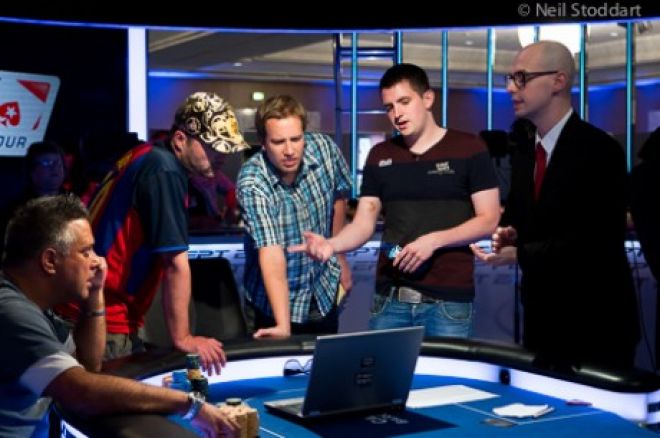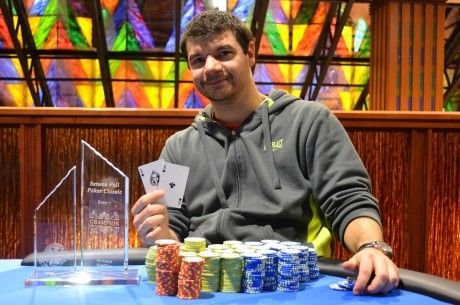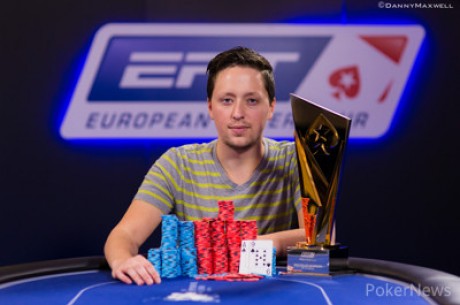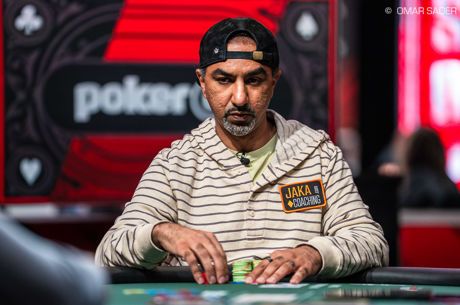Let��s Make a Deal: ��Chip Count�� and ��ICM�� Deals

Yesterday I met with my insurance agent. I stop by his office once a month to pay my bill. Usually he��ll ask me questions about how the poker world is going, a subject that often tends to be interesting to people outside of poker. Then he tries to sell me more insurance, I tell him I��m okay with what I have currently, and we wish each other well.
This time I told him a little about some of the recent tournaments I have been covering, and perhaps not coincidentally the conversation turned toward the subject of final table deals. I say not coincidentally both because I had the topic on my mind yesterday after starting our discussion about tournament deal-making and because the whole idea of making a final table deal is not that far removed from buying a kind of ��insurance�� against the inherent risks involved with tournament poker.
Insuring yourself against risk
Say you are one of four players left in a no-limit hold��em tournament that cost you $135 to play, and let��s say the remaining prizes are $4,000 for first, $2,500 for second, $2,000 for third, and $1,500 for fourth. All four of you are guaranteed at least $1,500, which isn��t such a bad return on your $135 investment. But you��re all also eyeing that $4,000 prize, too.
If you��re the chip leader with four left, you stand to have a better chance of getting that first prize than do the other players. But should you suffer an unlucky hand or two, you might find yourself the short stack and then in danger of going out in fourth.
It��s the knowledge of the risks associated with tournament poker �� and the significant role chance does play, especially at the end of a tourney when the blinds tend to be high and more often than not players have found it needful to edge over into an ��all-in-or-fold�� strategy �� that encourages some players to want to make deals to divide the remaining prize money rather than play out a tournament.
Like I say, making a deal is like buying insurance. You give up something, just like I did when I paid by agent yesterday. But you protect yourself against losing more later, as could happen if you bust in fourth and don��t get anymore of the remaining prize money up for grabs.
Different kinds of deals
Today I wanted to talk about two specific methods of calculating final table deals that are commonly used, especially in online events just as the tournaments that played out in the MicroMillions 6 series on PokerStars over the last couple of weeks.
Unlike in the bigger buy-in tournaments where a lot of seasoned pros and experienced players end up at the final tables, the small ��micro��-sized buy-ins in the MicroMillions tourneys mean there are usually a lot of players earning their first-ever prizes of several hundred dollars or even in the thousands. It's a new experience for many of those who make the MicroMillions final tables, and adds a lot to the fun of the series.
A lot of players who find themselves in this new position are understandably eager to make a final table deal and guarantee themselves, say, a prize of $1,000 or more for a $5.50 tourney. Also understandable is the fact that a lot of these MicroMillions players haven��t ever faced having to negotiate a final table deal, and thus sometimes find themselves at a handicap during that process, especially if there��s a player involved who does have some knowledge or experience when it comes to deals.
As it happened, 55 of the 100 tournaments in the MicroMillions 6 involved final table deals, and there were several more in which deals were discussed but never made. What happens is the remaining players tic a box to indicate their interest in talking about a deal, a ��host�� appears in the chatbox as a moderator, and generally what follows is the presentation of one or perhaps two different sets of figures with which to begin their negotiations.
One set of guaranteed payouts comes from calculations usually described as ��chip count�� or ��chip chop�� figures. The other is referred to as ��ICM�� numbers. Both might seem foreign to some, so I thought it would be useful to provide a quick explanation of both.
��Chip count�� or ��chip chop�� deals
For the sake of convenience, let��s use our four-handed example from above with those scheduled payouts of $4,000 for first, $2,500 for second, $2,000 for third, and $1,500 for fourth. That��s $10,000 total left in the prize pool, and by making a deal the four players are agreeing to alter the payouts from these previously scheduled amounts.
Now in MicroMillions tournaments and others on PokerStars, there��s generally a rule in place to set aside a certain amount of the prize pool to go to the eventual winner, with the players dividing up the rest. We��ll keep things simpler with our examples and not worry about setting aside the extra money for first.
One way to think of a ��chip count�� deal is to understand that a deal made according to that method assigns a particular cash amount to each of the remaining chips with every chip on the table being worth exactly the same. For an example, let��s say in this tournament there are exactly 1,000,000 chips in play, and let��s imagine the chip counts are as follows when the four players decide to make a deal:
| Position | Player | Chips |
|---|---|---|
| 1st | Alice | 320,000 |
| 2nd | Bill | 260,000 |
| 3rd | Charles | 220,000 |
| 4th | David | 200,000 |
A ��chip chop�� at this point would divide up the remaining $10K in the prize pool strictly on the basis of how the stacks were at the time of the deal. First, each player is guaranteed fourth-place prize money ($1,500), which sets $6,000 aside and leaves the remaining $4,000 to be divided up.
That remaining prize money is then divided strictly according to the present stacks, meaning the percentage of total chips each player has determines the percentage of the remaining prize money each gets. For example, Alice has 32 percent of the remaining chips, and so would get 32 percent of the $4,000 or $1,280 (i.e., $2,780 total). Here is how all of the payouts would look:
| Position | Player | Chips | Prize after ��chip count�� deal |
|---|---|---|---|
| 1st | Alice | 320,000 | $2,780.00 |
| 2nd | Bill | 260,000 | $2,540.00 |
| 3rd | Charles | 220,000 | $2,380.00 |
| 4th | David | 200,000 | $2,300.00 |
In this situation, no one will be getting as much as the scheduled first prize of $4,000, but no one gets fourth-place prize money ($1,500), either.
��Chip count�� deals are easy enough to calculate and thus for that reason alone might seem desirable for some players. However, what if Alice had a bigger chip lead at the time of the deal? How would that affect the proposed payouts? For example...
| Position | Player | Chips | Prize after ��chip count�� deal |
|---|---|---|---|
| 1st | Alice | 670,000 | $4,180.00 |
| 2nd | Bill | 150,000 | $2,100.00 |
| 3rd | Charles | 110,000 | $1,940.00 |
| 4th | David | 70,000 | $1,780.00 |
Notice a problem here? You should. If this deal were made, Alice would be getting more than the $4,000 scheduled to go to the winner!
This might seem like an absurd scenario that could never really happen, but in fact it does sometimes. Here's one example from a MicroMillions event in the spring where a four-handed deal almost resulted in an overwhelming chip leader getting more than first-place prize money. And here's another from the same series in which a three-handed deal was made (leaving some money for which to play) and the winner actually did earn more than the scheduled first-place prize (no shinola!).
I know I��ve seen this come up before, say, when six players discuss a deal and one of them has half the chips in play. The ��chip count�� figures are produced which would give the chip leader more than first-place prize money, and it��s always funny to see that player instantly type ��I agree�� in the chatbox. Usually the others catch on and such a deal isn��t accepted, but not always!
Deals based on ��ICM�� (Independent Chip Model)
Often what will happen when the ��chip count�� numbers don��t look good to everyone is for someone to request that ��ICM�� figures to be produced, with the acronym standing for ��Independent Chip Model.��
The topic of ICM is too complicated for us to delve into that deeply here �� it��s relevance to tournament poker extends beyond just the area of final-table deals. But the concept behind it is easy enough to understand. Like with the ��chip count�� method, the ICM method also assigns cash value to the chips in play. However, ICM does not consider each chip to be of equal value, but rather accommodates for the fact that chips change in value as a tournament goes along. It��s a calculation that takes into account each player��s chance of finishing in each of the remaining positions (based on the players�� relative stacks), then multiplies those percentages and adds them up to figure out a theoretical cash value for each player��s stack.
Many tournament players think of the ICM method as being a fairer guide for deal-making because it avoids the obvious problems suggested by that last example. No one is going to be offered more than first-place money according to an ICM-based deal, nor is anyone going to be asked to take a deal in which they��d receive less than what the next eliminated player is scheduled to receive.
By way of comparison, let��s look again at those two scenarios listed above and see how the payouts would go if the ICM method was used. Remember, the scheduled payouts are $4,000, $2,500, $2,000, and $1,500. First, here��s the one in which the four players�� stacks were pretty close:
| Position | Player | Chips | Prize after ��ICM�� deal |
|---|---|---|---|
| 1st | Alice | 320,000 | $2,699.85 |
| 2nd | Bill | 260,000 | $2,537.58 |
| 3rd | Charles | 220,000 | $2,414.78 |
| 4th | David | 200,000 | $2,347.79 |
And here��s the one in which Alice had the big chip lead and the others were all especially short:
| Position | Player | Chips | Prize after ��ICM�� deal |
|---|---|---|---|
| 1st | Alice | 670,000 | $3,460.73 |
| 2nd | Bill | 150,000 | $2,370.83 |
| 3rd | Charles | 110,000 | $2,197.61 |
| 4th | David | 70,000 | $1,970.83 |
Like I say, the calculations are a little tedious to explain �� especially at the end of an already long article �� but understand that essentially what��s happening is each player��s chip stack is being looked at as representing the chance that player will be finishing first, second, third, or fourth, then those percentages are multiplied by the payouts and the totals are added up to indicate amount the player is due (an amount referred to in some contexts as the player��s ��equity�� in the tournament).
By the way, when heads-up the figures produced by the ��chip count�� and ��ICM�� methods are identical.
Comparing ��chip count�� and ��ICM�� methods
Here��s the takeaway, and what I��d like you to keep in mind should you ever find yourself at the end of a MicroMillions or some other tournament and suddenly involved in a deal discussion in which these ��chip count�� and ��ICM�� numbers are being thrown at you: ��chip chop�� deals favor the bigger stacks and punish the short stacks (sometimes outrageously in both cases), while ICM-based deals are more advantageous for the short stacks and less so for the leaders.
In the MicroMillions events, it often happens that when the deal is proposed both sets of numbers are provided to the players right off the top, and inevitably the leader will say he or she favors ��chip count�� numbers while the others will argue for ��ICM.��
Sometimes you��ll see a savvy player make a preference known even before the numbers are produced, but when that happens you still will see the same prejudices firmly in place �� that is, the chip leader who perhaps has been involved in a final table before will say ��I��ll look at the numbers, but it��s chip chop, no ICM for me.�� If the others aren��t aware, they may not even ask to look at ICM numbers, thus increasing the likelihood the leader will get his way.
When both sets of numbers are given, they often become guidelines for the players to find some middle ground. You��ll also see players arguing for more, occasionally bringing up a record of tourney success as a basis for suggesting they deserve more from a deal than do less experienced players. This is where your negotiating skills will be challenged, and just like you were practicing a form of ��buying�� and ��selling�� in the hands you played against your opponents up to that point, now you might find yourself involved in a different though related form of haggling.
When deals are brought up at the final tables of live tourneys, often the figures that are discussed are suggested by the players themselves, usually guided by the current chip stacks with the players�� relative experience sometimes also brought into the discussion. Occasionally, though, even in a live setting players might consult an ICM calculator as a guide.
For example, at the EPT10 Barcelona Main Event back in September eventually won by Tom Middleton, there was a deal discussion at four-handed and a laptop was produced to help the players crunch some numbers (see the photo up top). For an interesting explanation of how that negotiation in Barcelona went �� and ultimately produced no deal among the four players �� see ��The Delicate Balance of EPT Negotiations�� by Rick Dacey.
We��ll continue on Friday with one last installment to talk a little further about reasons for and against making final table deals. Not everyone likes to make them, and the arguments those players propose are worth considering before you jump into making your own final table deals.
Meanwhile, I hope the discussion so far will prove helpful to you if you ever find yourself in the middle of a final table deal discussion, preparing you at least somewhat for what to expect. Kind of like how I like to be prepared for my insurance agent trying yet again to sell me more coverage every time we meet.
Photo courtesy Neil Stoddart/PokerStars.
Get all the latest PokerNews updates on your social media outlets. Follow us on Twitter and find us on both Facebook and Google+!








